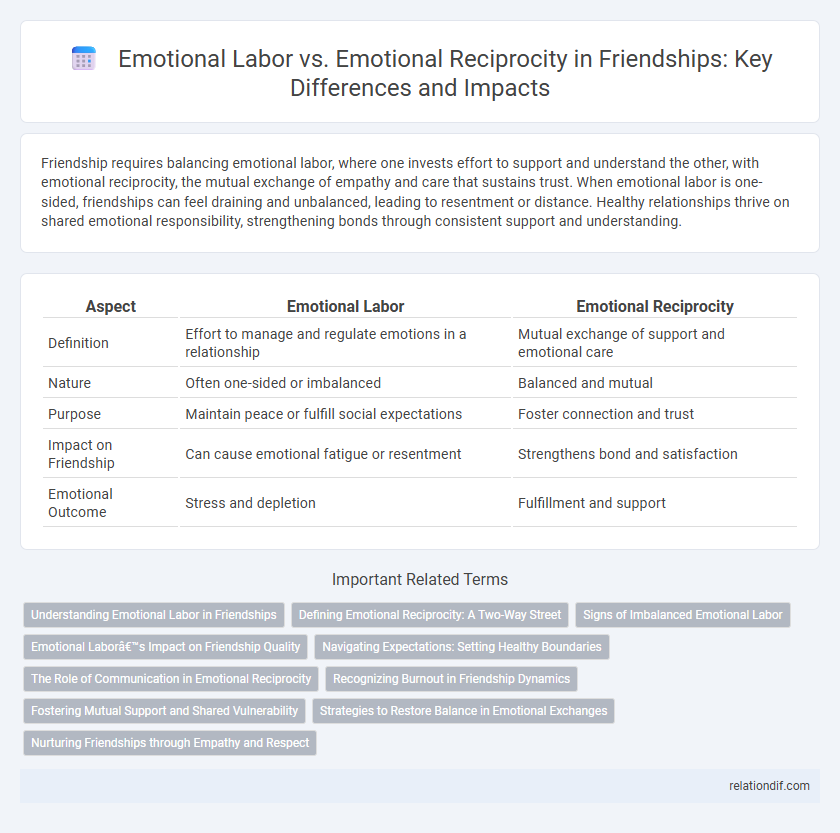Friendship requires balancing emotional labor, where one invests effort to support and understand the other, with emotional reciprocity, the mutual exchange of empathy and care that sustains trust. When emotional labor is one-sided, friendships can feel draining and unbalanced, leading to resentment or distance. Healthy relationships thrive on shared emotional responsibility, strengthening bonds through consistent support and understanding.
Table of Comparison
| Aspect | Emotional Labor | Emotional Reciprocity |
|---|---|---|
| Definition | Effort to manage and regulate emotions in a relationship | Mutual exchange of support and emotional care |
| Nature | Often one-sided or imbalanced | Balanced and mutual |
| Purpose | Maintain peace or fulfill social expectations | Foster connection and trust |
| Impact on Friendship | Can cause emotional fatigue or resentment | Strengthens bond and satisfaction |
| Emotional Outcome | Stress and depletion | Fulfillment and support |
Understanding Emotional Labor in Friendships
Emotional labor in friendships involves the intentional effort one invests to support, comfort, and manage the emotional well-being of friends, often requiring empathy and active listening. Unlike emotional reciprocity, where emotional support flows mutually and naturally between friends, emotional labor may create imbalance if one person consistently undertakes the emotional maintenance. Recognizing the difference helps ensure friendships remain healthy by fostering mutual understanding and shared emotional responsibility.
Defining Emotional Reciprocity: A Two-Way Street
Emotional reciprocity in friendship involves the balanced exchange of feelings and support, where both parties actively contribute to each other's emotional well-being. This two-way street contrasts with emotional labor, which occurs when one person consistently manages the emotional needs of the relationship without receiving equivalent support in return. Healthy friendships thrive on mutual emotional investment, fostering trust, understanding, and resilience.
Signs of Imbalanced Emotional Labor
Signs of imbalanced emotional labor in friendship include consistently one-sided support where one person always provides comfort and advice without receiving the same in return. Emotional exhaustion, resentment, and feeling undervalued often arise when emotional reciprocity is lacking. Healthy friendships exhibit mutual understanding, where both parties share vulnerabilities and offer consistent empathy and encouragement.
Emotional Labor’s Impact on Friendship Quality
Emotional labor in friendships involves the consistent effort one invests in managing their own and others' emotions, often leading to imbalance and strain when not reciprocated. This unidirectional emotional labor can diminish friendship quality by increasing feelings of resentment and emotional exhaustion. Balanced emotional reciprocity fosters mutual support, enhancing trust and satisfaction, which are critical for maintaining long-term friendship health.
Navigating Expectations: Setting Healthy Boundaries
Emotional labor in friendship involves consistently managing and supporting a friend's feelings, while emotional reciprocity requires mutual sharing and understanding to maintain balance. Navigating expectations by setting healthy boundaries prevents emotional exhaustion and fosters trust, ensuring both parties feel valued without overextending themselves. Prioritizing clear communication about needs and limits strengthens emotional resilience and promotes sustainable, fulfilling friendships.
The Role of Communication in Emotional Reciprocity
Effective communication is crucial in emotional reciprocity within friendships, as it enables individuals to express feelings authentically and respond empathetically. Open dialogue fosters mutual understanding, balancing emotional labor by ensuring that support and care are exchanged rather than one-sided. Consistent verbal and non-verbal cues help maintain emotional equilibrium, strengthening the bond and sustaining long-term relational satisfaction.
Recognizing Burnout in Friendship Dynamics
Emotional labor in friendship involves one person consistently providing support, which can lead to burnout when emotional efforts are unreciprocated. Recognizing burnout requires noticing signs such as increased irritability, withdrawal, or feeling drained after interactions. Balanced emotional reciprocity helps maintain healthy dynamics by ensuring mutual care and preventing exhaustion in the friendship.
Fostering Mutual Support and Shared Vulnerability
Emotional labor in friendship involves consistently providing support and managing feelings for others, which can create imbalance if not reciprocated. Emotional reciprocity fosters mutual support and shared vulnerability, strengthening trust and deepening connections. Prioritizing reciprocal emotional exchanges encourages authentic bonds where both friends feel valued and understood.
Strategies to Restore Balance in Emotional Exchanges
Restoring balance in emotional exchanges within friendships involves setting clear boundaries to prevent emotional exhaustion and encouraging open communication to express feelings and needs honestly. Practicing emotional reciprocity requires recognizing when one-sided support occurs and actively fostering mutual empathy by offering support as much as receiving it. Implementing strategies like scheduled check-ins and shared vulnerability can strengthen trust, ensuring both friends contribute equitably to the emotional labor involved.
Nurturing Friendships through Empathy and Respect
Emotional labor in friendships involves investing time and energy to support a friend's feelings, often without immediate reciprocation, which can lead to imbalance if unacknowledged. Emotional reciprocity fosters a mutual exchange of empathy and respect, strengthening bonds and ensuring both parties feel valued and understood. Prioritizing empathy and respect in interactions nurtures friendships by creating a safe space for open communication and genuine connection.
Emotional Labor vs Emotional Reciprocity Infographic

 relationdif.com
relationdif.com